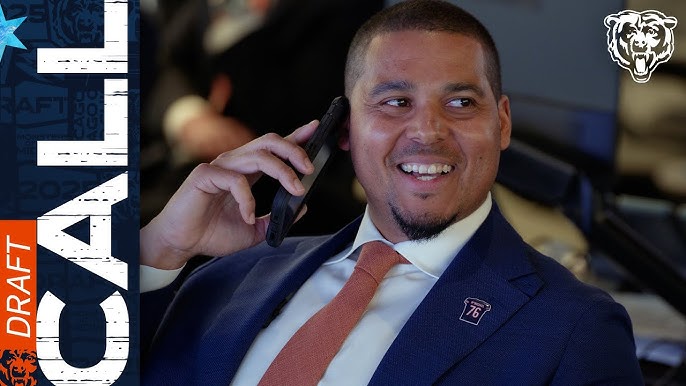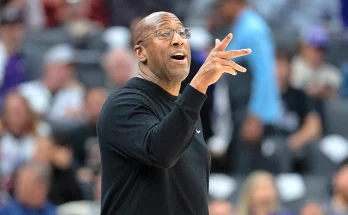The call came just after the second round began, sometime in the early evening, when the energy in the draft room had quieted just enough to hear the buzz of a phone. Colston Loveland, seated on a leather couch surrounded by his family, coaches, and a few close friends, stared at the caller ID for a moment. The area code read “847.” Illinois. Chicago. His heart skipped a beat. His mother, noticing the sudden shift in his expression, leaned in. He nodded slowly and picked up.
“Colston? Ryan Poles with the Chicago Bears. You ready to be a Bear?”
That’s when the room erupted.
Loveland had spent the entire day trying to stay even-keeled, knowing full well how unpredictable the NFL Draft could be. For every surefire first-round pick, there were countless stories of players projected for Day 1 slipping deep into Day 2 or even Day 3. Still, he had reason to be confident. Over the past two seasons at Michigan, Loveland had blossomed into one of the most complete tight ends in college football. His 6-foot-5 frame, soft hands, precise route running, and fearless demeanor across the middle made him a matchup nightmare. He blocked with the grit of an offensive lineman and caught passes like a wide receiver. NFL scouts had taken notice. So had the Bears.
For Chicago, the decision had been building for weeks. Despite needs across the board—offensive line, pass rush, secondary—they couldn’t ignore the potential of pairing a dynamic young tight end with new quarterback Caleb Williams. Williams, the No. 1 overall pick, had just been announced hours earlier. Bringing in a target like Loveland wasn’t just smart—it was strategic. It was a sign that the Bears were thinking long-term, building chemistry from the ground up.
Loveland wasn’t just another draft pick. He was a signal of identity.
Raised in the tiny town of Gooding, Idaho—a place with fewer than 4,000 residents—Loveland grew up with dreams much bigger than his zip code. He was the type of kid who shoveled his own driveway at 5 a.m. so he could get extra reps in the weight room before school. He played through minor injuries without complaint, never asked out of a drill, and always seemed to be the last one off the field. That blue-collar mentality stayed with him as he took the leap to Ann Arbor, where he didn’t just survive the jump in competition—he thrived.
As a freshman at Michigan, Loveland’s role started small. He was largely used as a blocker, working in behind upperclassmen and occasionally getting sprinkled into the passing game. But it didn’t take long for the coaching staff to realize he was more than just a big body. During his sophomore season, Loveland emerged as one of J.J. McCarthy’s most trusted targets. He had a knack for finding soft spots in zone coverage, a fearlessness across the middle, and a rare ability to high-point balls in the red zone. He finished the season with over 600 receiving yards and six touchdowns, but stats didn’t tell the whole story. It was the clutch catches in big moments—third downs against Penn State, a touchdown grab over the middle in the Big Ten title game—that truly defined him.
Scouts raved about his balance of finesse and physicality. He wasn’t the flashiest player in the draft, but he might’ve been the most dependable. That’s what attracted the Bears. That’s what made Ryan Poles pull the trigger.
Loveland, still on the phone with the Bears GM, tried to soak it all in. He could hear cheers in the background. Someone—maybe a coach, maybe a scout—yelled out, “We got our guy!” Loveland smiled. He looked over at his father, who was wiping away tears, and gave him a firm nod. This was for them. For Gooding. For every early morning, every freezing winter workout, every overlooked snap.
In Chicago, the fit feels seamless. With Cole Kmet already on the roster, the Bears now boast a two-headed monster at tight end—one that can stress defenses in multiple ways. Kmet, the veteran with size and toughness, will continue to do the dirty work. Loveland, the rookie with upside and athleticism, can stretch the field and find holes in coverage. Together, they offer balance and versatility, two things every young quarterback craves.
But make no mistake—Loveland isn’t coming to Chicago to play second fiddle. He’s coming to make an impact from Day 1. His skill set demands it.
Inside Halas Hall, the buzz surrounding Loveland’s selection is palpable. Coaches are already scheming ways to use him—lining him up in the slot, motioning him out wide, creating mismatches against linebackers and safeties. Offensive coordinator Shane Waldron, who arrived in Chicago after a successful stint in Seattle, sees a little bit of George Kittle in Loveland. Maybe not in pure explosiveness, but in attitude. In approach. In the way he plays every snap like it’s his last.
“Colston’s one of those guys who makes you better just by being on the field,” Waldron said in a post-draft press conference. “His energy is contagious. He brings it every play, and he doesn’t need to be asked twice. That’s rare.”
Loveland, for his part, is saying all the right things. At his introductory media availability, he talked about the opportunity in front of him, the legacy of the Bears, and the honor of wearing the same jersey as legends like Mike Ditka. He smiled often, gave credit to his teammates and coaches at Michigan, and made it clear he wasn’t taking any of this for granted.
“I know nothing’s given in this league,” he said. “I’ve got to earn every snap, every catch, every block. That’s how I’ve always approached football. That’s how I’ll approach it here.”
It’s easy to believe him. Watch five minutes of tape, and it becomes clear that Loveland doesn’t cut corners. He doesn’t take plays off. He doesn’t get caught up in the noise. He’s exactly the kind of player Chicago needs right now—not just talented, but grounded. Not just explosive, but reliable. In a city known for its toughness and tradition, Loveland feels like a perfect fit.
Back in Gooding, his former coaches and teachers are beaming. The local high school gym has already put up a new banner: “Home of NFL Draft Pick Colston Loveland.” Students wear Michigan hats and now, some Bears gear. The town is rallying, the way small towns always do when one of their own breaks through. For them, Loveland’s success isn’t just personal—it’s communal. It’s proof that work ethic still matters. That character still counts. That big dreams can come from small places.
As training camp approaches, expectations will rise. The NFL is unforgiving, and the transition is rarely smooth. There will be bumps. There will be lessons. But Loveland has never been afraid of hard work. He’s never been afraid of a challenge. That’s what got him here in the first place.
When he walks into the Bears facility for the first time, he’ll do it the same way he approached his first lift in high school, his first practice at Michigan, his first bowl game against Alabama. With his head down, heart open, and hands ready. Ready to catch whatever’s thrown his way.
In a league filled with hype and headlines, Colston Loveland represents something refreshingly simple—a football player’s football player. A guy who lets his game do the talking. And now, with the city of Chicago behind him and a golden opportunity in front of him, he’s ready to show the world what Gooding, Idaho already knew:
He was built for this.


